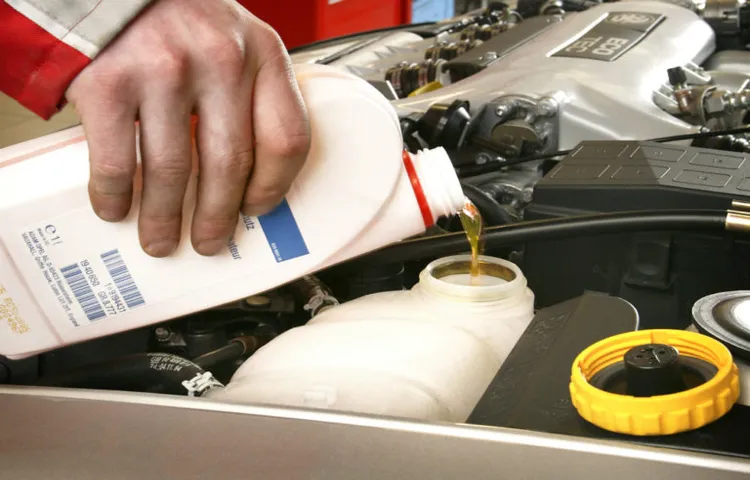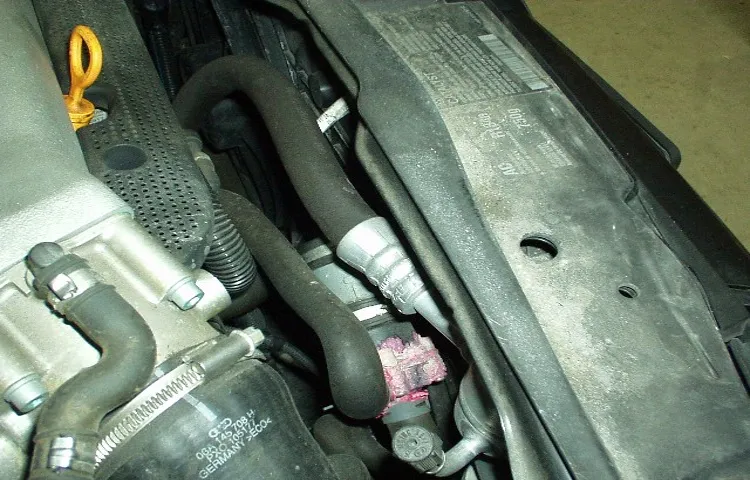Do you ever glance down at your dashboard and see a flashing coolant light? It can be intimidating, especially if you’re unsure what it means. But don’t worry, understanding your coolant system is easier than you might think. In short, your coolant light may illuminate if your engine is overheating or if there is an issue with your car’s coolant system.
However, coolant issues can range from minor to major problems, so it’s important to identify the issue and take immediate action. Think of your coolant system like the circulatory system in your body – if one part isn’t functioning correctly, it can cause problems elsewhere. In this blog, we will break down the components of your coolant system and help you identify the culprit behind your coolant light.
Table of Contents
What is a Coolant System?
If you’re wondering why your coolant light is on, it’s probably because something’s up with your vehicle’s coolant system. But what exactly is a coolant system? Simply put, it’s the part of your car that regulates the temperature of the engine and keeps it from overheating. Coolant, a mixture of water and antifreeze, is constantly circulated through the engine by a pump, absorbing excess heat and transferring it to the radiator, where it’s released into the air.
Without a working coolant system, your engine could overheat and cause severe damage, so it’s important to keep an eye on your coolant levels and have your system regularly inspected by a mechanic. If your coolant light is on, it’s a good idea to pull over and check the coolant level and temperature gauge before continuing to drive. If you’re low on coolant or notice any leaks or other issues, don’t delay in getting your car serviced.
Remember, an ounce of prevention is worth a pound of cure!
Explaining the Components and Function
A coolant system, also known as a cooling system, is a vital component in the functioning of a vehicle’s engine. This system is responsible for preventing the engine from overheating by transferring heat away from it and into the surrounding air. The coolant system consists of a few key components, including the radiator, water pump, thermostat, and hoses.
The radiator acts as a heat exchanger that cools the engine coolant with the help of the air flow. The water pump circulates coolant throughout the system and maintains the correct pressure. The thermostat helps regulate the engine temperature by controlling the flow of coolant.
Lastly, the hoses connect all of the components within the system, allowing coolant to flow freely. Without this system, engines could easily overheat and incur significant damages.

Reasons Why Your Coolant Light Could Be On
If your coolant light is on, there are several reasons why this may be happening. The first and most obvious reason is that your engine may be running hot, which can happen for a variety of reasons, such as a malfunctioning radiator, a worn-out water pump, or a thermostat that isn’t working correctly. Another possible reason for the coolant light being on is that there may be a leak in the cooling system, which could be caused by a faulty radiator hose or a damaged water pump.
Additionally, your coolant level may be low, which could be due to a leak or simply the need for a coolant top-up. Finally, your coolant sensor may be malfunctioning, which can cause the light to come on even if there is no actual problem with your vehicle. Whatever the cause, it’s essential to address the issue promptly to prevent more extensive and costly damage to your engine.
Low Coolant Level and What It Means
Having your low coolant light come on can be quite worrying, but it’s essential to understand what’s causing it. There are several reasons why your coolant light could be on, including a low coolant level. It could indicate a leak, a faulty thermostat, or a damaged water pump.
Low coolant levels can cause your engine to overheat, leading to significant engine damage. It’s crucial to address the issue right away to prevent additional damage to your engine. If you’re unsure about what’s causing your low coolant light to come on, it’s best to have your vehicle inspected by a trusted mechanic.
By identifying the root cause of the issue, you can prevent any future troubles and keep your vehicle running smoothly. Always remember that prevention is better than cure, so don’t ignore any warning lights that come on in your car.
Leakages and How to Identify Them
Coolant light One of the most common reasons why your coolant light could be on is a leakage in the coolant system. Coolant leaks can happen at various points, including the radiator, water pump, hoses, and heater core. The coolant helps regulate your engine’s temperature, and having a low coolant level can lead to overheating and engine damage.
To identify a coolant leak, look for puddles of fluid under your car, low coolant levels, an overheating engine, or a sweet, syrupy smell coming from your engine. It is essential to address coolant leaks promptly, as they can lead to costly repairs and even engine failure. Regularly checking and maintaining your coolant system can help you avoid these issues and keep your engine running smoothly.
So, if you notice your coolant light is on, it is essential to get to the root of the problem before it becomes worse.
Radiator Issues that Cause Coolant Light to Turn On
If you have noticed that your coolant light has turned on, it may indicate a problem with your vehicle’s radiator. Radiator issues can cause the coolant light to turn on, and it’s important to diagnose and fix the issue before it leads to further problems. One common reason for the coolant light to turn on is a leak in the radiator.
This can be caused by corrosion, pressure, or other factors, and may result in a loss of coolant. Another potential issue is a malfunctioning thermostat, which is responsible for regulating the engine’s temperature. A faulty thermostat may cause the coolant light to turn on, and can also result in overheating.
Other issues to consider include a clogged radiator or a damaged coolant pump. If your coolant light has turned on, it’s important to have your vehicle inspected by a professional mechanic to determine the cause of the problem and prevent further damage.
What to Do When Your Coolant Light is On
When your coolant light turns on, it can be alarming. No one wants to see warning lights on their dashboard. However, it’s important not to panic and instead take the appropriate steps to diagnose and fix the issue.
The most common reason for the coolant light to turn on is that the engine is overheating or that there’s a coolant leak. One way to check for a leak is to look for puddles of coolant under your vehicle or to inspect the coolant levels in the reservoir tank. In some cases, a faulty sensor can also trigger the coolant light.
If you are unsure about the cause of the light, it’s best to consult with a mechanic or auto technician who can diagnose and repair the issue. Ignoring a coolant light can lead to serious engine damage, so it’s important to address the problem as soon as possible.
Immediate Steps to Take When You Notice the Light On
Coolant Light Have you ever been driving down the road and suddenly noticed the coolant light blinking on your dashboard? When this happens, it’s important to take immediate action to avoid serious engine damage. The first step is to pull over as soon as possible and turn off your engine. Once you’ve done this, it’s time to take a closer look at your coolant level.
Check to see if your coolant level is low and if so, fill it up with the appropriate fluid. If the coolant level seems to be fine, then there could be a more serious issue at play, such as a damaged radiator or a failing water pump. In this case, it’s best to call your mechanic and have them diagnose the problem before you proceed any further.
Remember, addressing the coolant light immediately can ultimately save you from costly repairs down the road.
Preventive Measures to Ensure Your Car’s Coolant System Stays Healthy
One of the most concerning warning lights that can turn on in your car dashboard is the coolant light. This could indicate several problems with your car’s cooling system, such as low coolant levels, a damaged radiator, or a malfunctioning thermostat. Therefore, it is essential not to ignore this sign and take preventive measures to ensure your car’s coolant system stays healthy.
To begin with, regularly check your car’s coolant levels and top it up if needed. Also, ensure that the coolant mixture is correct for the vehicle and the weather. Another preventive technique is to flush your car’s cooling system at least once every two years to remove any potential buildup of debris.
If your coolant light does turn on, immediately turn off your car’s engine and allow it to cool down before checking the coolant levels. It is advisable not to drive your car if the coolant light is on as it could cause irrevocable harm to the engine. Remember, early detection and proactive maintenance could save you a considerable amount of time and money in the long run.
Conclusion
Well, it looks like your car has a bit of a cold shoulder towards you, with its coolant light on. Don’t worry, it’s not personal. Your car is just trying to tell you that it needs some attention in the cooling department.
Maybe it’s time for a coolant flush, or there’s a leak somewhere. Whatever the reason may be, it’s best not to ignore it and give your car the TLC it deserves. Trust me, your car will thank you with smoother rides and no more awkward silence with that pesky warning light on.
“
FAQs
What does a coolant light indicate?
A coolant light usually indicates that the engine’s cooling system is not functioning properly, causing the engine to overheat.
Can I still drive my car with the coolant light on?
It’s not recommended to drive your car with the coolant light on as it may cause serious damage to your engine. It’s best to pull over and turn off your engine as soon as possible.
How do I check my coolant level?
You can check your coolant level by opening the hood, locating the coolant reservoir, and checking the level of the coolant. Make sure to check when the engine is cold.
What should I do if my coolant level is low?
You should add coolant to the reservoir in small amounts until it reaches the appropriate level. If your coolant level consistently drops, it may indicate a leak in the system that needs to be repaired.
How often should I check my coolant level?
It’s recommended to check your coolant level every time you fill up your gas tank or at least once a month.
Can a faulty coolant sensor cause the coolant light to turn on?
Yes, a faulty coolant sensor can cause the coolant light to turn on even when the coolant level is appropriate.
What should I do if the coolant light continues to turn on even after adding coolant?
If the coolant light continues to turn on after adding coolant, it may indicate a bigger problem with the cooling system, and you should take your car to a mechanic to diagnose and repair the issue.


